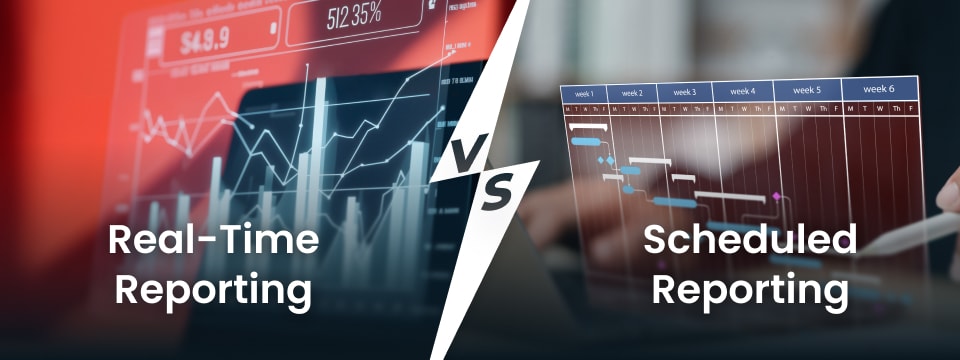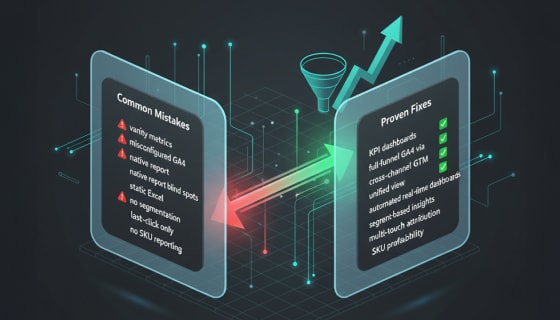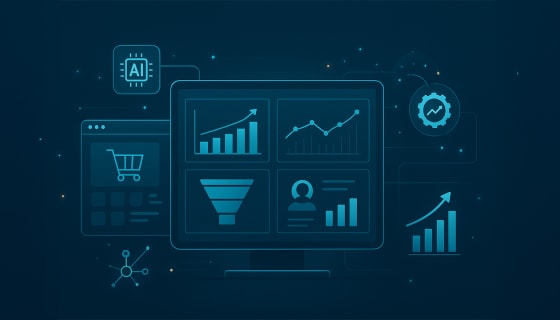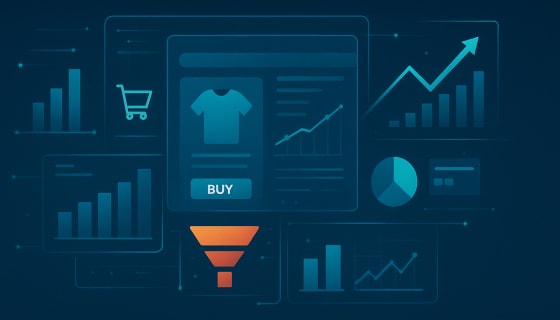Data reporting isn’t just about collecting numbers—it’s about interpreting them in a way that drives decisions. CEOs and CXOs rely on data analysts to transform raw data into actionable insights that shape business strategies. By evaluating patterns, identifying trends, and predicting outcomes, analysts enable businesses to stay ahead of the competition and make informed, data-driven decisions.
When it comes to reporting, businesses often find themselves weighing two primary methods: real-time reporting and scheduled reporting. Each offers unique advantages, but knowing when and how to use them is crucial for extracting the most value from your data.
In this blog, we’ll explore the differences between real-time and scheduled reporting, highlighting the benefits and limitations of both. By understanding these reporting methods, you’ll be better equipped to select the right one for your business, improve decision-making, and ensure that your data works for you, whether you need immediate insights or a structured, long-term view of your operations.
What Real-Time Reporting Is and How It Benefits Your Business
Real-time reporting refers to the ability to access, analyze, and report data as it’s generated, providing immediate insights into ongoing business activities. This immediate access to up-to-date information is crucial for decision-makers who must respond quickly to changing circumstances or new opportunities. In industries such as e-commerce, healthcare, and manufacturing, real-time data enables businesses to adjust their strategies swiftly and effectively.
Benefits of Real-Time Reporting
- Instant Decision-Making: With real-time reporting, businesses can make informed decisions based on the latest data. This agility is crucial in fast-paced industries that require rapid adjustments.
- Enhanced Customer Experience: Real-time data enables businesses to address customer needs promptly and effectively. Instant access to information leads to quicker resolutions, enhancing customer satisfaction and fostering loyalty.
- Increased Operational Efficiency: In complex operations, real-time reporting allows businesses to track processes and outcomes as they happen. This transparency reduces errors, accelerates decision-making, and streamlines business functions.
- Predictive Insights: By analyzing real-time data, businesses can more accurately predict trends and behaviors. For instance, real-time customer purchase patterns can drive timely marketing strategies and product recommendations.
Consider Amazon, a leader in e-commerce. Amazon’s use of real-time data enables it to track customer actions, update inventory, and optimize delivery routes in real-time. This operational efficiency has enabled Amazon to maintain its competitive edge and grow rapidly in the e-commerce sector.
While real-time reporting offers instant insights, scheduled reporting provides businesses with structured data for better long-term planning and analysis.
What Scheduled Reporting Is and How It Improves Business Efficiency
Scheduled reporting refers to the practice of generating reports at predetermined intervals, such as daily, weekly, or monthly, based on specific data sets. It gives businesses a comprehensive overview of key metrics over time. This method is often used for tracking long-term trends, performance metrics, and business outcomes. This type of reporting is crucial for businesses that require structured, consistent data for informed decision-making and strategic development.
Benefits of Scheduled Reporting
- Structured Decision-Making: Scheduled reporting enables businesses to make informed decisions based on regular intervals of data, providing a clearer picture of trends and performance over time. This approach is beneficial for analyzing monthly sales, quarterly earnings, or year-over-year comparisons.
- Consistency and Accountability: By generating reports on a set schedule, businesses ensure that data is consistently tracked and evaluated. This fosters accountability within departments and helps identify areas that need attention before issues become critical.
- Resource Optimization: Scheduled reports provide businesses with timely, well-organized insights without the need for continuous monitoring. This frees up valuable resources, allowing teams to focus on more strategic tasks while still having access to essential data.
- Strategic Planning: Having regular, scheduled reports enables better strategic planning. For example, a business might use monthly reports to assess marketing effectiveness, financial health, or employee performance, aligning decisions with long-term goals.
A notable example of scheduled reporting in action is Walmart, one of the world’s largest retailers. Walmart’s use of scheduled reporting ensures that it consistently tracks key metrics, such as sales trends and inventory levels, allowing it to optimize stock management, predict customer demand more accurately, and adjust pricing strategies, ultimately driving efficiency across its global retail network.
Now that you’ve understood the key differences between real-time and scheduled reporting, it’s time to assess which method fits your business’s goals.
How Real-Time and Scheduled Reporting Work for Your Business
In a data-driven world, businesses can no longer rely on just one reporting method. While real-time reporting and scheduled reporting each offer distinct advantages, combining them can provide a comprehensive approach to data analysis that benefits your organization in multiple ways.
Complementing Immediate Insights with Long-Term Trends
Real-time reporting provides businesses with immediate data; however, scheduled reporting offers a broader view of performance over time, enabling them to evaluate trends, adjust forecasts, and track progress toward long-term objectives. For example, real-time reporting might highlight a surge in online sales. In contrast, scheduled reporting can provide deeper insights into the seasonal trends behind that spike, giving a comprehensive picture for more informed decisions.
Agility and Strategic Planning in One
Real-time data enables you to react instantly, while scheduled reporting provides the insights needed to make strategic decisions, such as planning for the next quarter, optimizing resource allocation, and reviewing financial health. For example, while real-time reporting might indicate that a particular product is underperforming in the market, scheduled reports provide historical sales data, showing if this decline is seasonal or part of a longer-term trend.
Maximizing Efficiency
Real-time reporting can be set up for critical areas that require immediate attention, such as customer service or sales performance. Meanwhile, scheduled reports can handle more routine tracking, including monthly financial summaries and quarterly marketing performance reports. This division of labor ensures that you’re not spending all your time reacting to the latest data but also stepping back to analyze patterns over time. By balancing both methods, businesses can optimize their operational efficiency while remaining aligned with their strategic objectives.
When used together, real-time and scheduled reporting create a powerful and dynamic system that helps businesses remain both agile and strategic. This combination enables:
- Faster, data-driven decisions that are also aligned with long-term business goals.
- Increased operational efficiency by ensuring that short-term issues are addressed while long-term strategies are in place.
- Better resource allocation, where immediate needs are met with real-time data and future growth is supported with well-thought-out plans.

By combining real-time and scheduled reporting, businesses can achieve the perfect balance between immediate action and strategic foresight, ensuring both operational efficiency and long-term success.
Exploring the Pros and Cons of Real-Time and Scheduled Reporting
When deciding between real-time reporting and scheduled reporting, it’s essential to consider how each method aligns with your business needs and objectives. Each has its strengths and is best suited for different situations. Real-time reporting and scheduled reporting work hand in hand. While real-time reporting helps drive short-term actions, scheduled reports provide the context needed for long-term planning. The ability to balance both approaches ensures that businesses remain agile and responsive while also staying aligned with their overarching goals.
For instance, in a retail environment, real-time data is invaluable for tracking customer behavior, inventory levels, and sales trends as they happen. This allows businesses to react quickly, restocking inventory in real-time, offering instant customer support, or adjusting marketing campaigns on the fly. On the other hand, scheduled reporting comes into play when businesses need to evaluate their performance over a more extended period. Monthly or quarterly reports provide a deeper understanding of trends, enabling companies to assess their overall strategy, optimize resources, and forecast future performance.
To help you make a well-informed decision, we’ve summarized the pros and cons of both real-time and scheduled reporting in the image below.

This visual comparison will help you weigh the pros and cons of each method, making it easier to choose the right reporting approach for your business.
How to Choose the Right Reporting Method for Your Business
Choosing the correct reporting method depends on several key factors that align with your business’s unique needs. To make an informed decision, consider the following:
- Industry Needs: Different industries have different requirements for data reporting. For example, eCommerce businesses may rely heavily on real-time reporting to track customer behavior and adjust marketing efforts. In contrast, manufacturing businesses prefer scheduled reporting to monitor production and inventory over time.
- Available Resources: Real-time reporting often requires additional resources, such as technology, tools, and personnel, to continuously track and analyze data. If your business has limited resources, scheduled reporting might be more manageable, as it doesn’t require constant monitoring.
- Business Goals: The choice between real-time and scheduled reporting should align with your business goals. If your focus is on immediate responsiveness and adapting quickly to changes, real-time reporting is a more suitable option. If your focus is on long-term planning, trend analysis, and strategy development, scheduled reporting might be a better fit.
To choose the proper reporting method, it’s crucial to align it with your business objectives. The key question is: What are you trying to achieve with this data? Whether you’re aiming for quick decision-making, long-term strategy, or resource optimization, your reporting method should directly support these goals.
Instead of just looking at data, ask yourself the right questions to determine what fits:
Know Thyself
- Do I need immediate, actionable insights to adjust to changing conditions?
- Am I looking for periodic, in-depth analysis to track progress over time?
- What are the key decisions I need to make, and how often do I need updated information?
- How does this reporting method tie into my company’s long-term vision?
Answering these questions will help you make the right decision, ensuring your reporting strategy is directly aligned with the results you want to drive.
How ZealousWeb Helps You Optimize Data Analytics and Reporting
While data reporting provides the structure and clarity needed to evaluate business performance, data analytics takes it a step further by offering a deeper understanding of what that data means. By combining both real-time and scheduled reporting with advanced data analytics, businesses can unlock new opportunities for growth and innovation.
One powerful aspect of data analytics is predictive analytics, which leverages historical data to predict future outcomes. Machine learning and AI algorithms help businesses to anticipate what will happen next, enabling proactive decision-making. Give a read to our recent blog to learn more about predictive analysis in detail. Another effective way to present your data is through data visualization. Humans process visuals faster than text or numbers, so using graphs, charts, and dashboards makes data more accessible and easier to digest. This is where platforms like Power BI and Tableau offer customizable and interactive dashboards that allow you to drill down into specific data points for deeper insights.
To take a step ahead, businesses utilize data from a variety of sources, including website analytics, CRM systems, social media platforms, and sales reports. Data integration is essential to ensure that all this information is consolidated into a single, cohesive system for analysis and reporting.
ZealousWeb helps businesses integrate data from multiple sources, ensuring a single source of truth for all your reporting needs. This integration ensures that your decisions are based on comprehensive, up-to-date data rather than fragmented or outdated reports.
We offer:
- Advanced data modeling and predictive analytics to help you anticipate trends and optimize decision-making.
- Custom dashboards and visualizations to make data easy to understand and actionable.
- Seamless data integration from multiple sources ensures that all your business data works together.
Conclusion
Choosing the proper reporting method can be a game-changer for your business. Businesses that use data-driven strategies are proven to perform better, with studies showing that data-driven organizations are 23 times more likely to acquire customers and 19 times more likely to be profitable.
The key is to align your reporting strategy with your business goals. And remember, it’s not about choosing one method and sticking with it forever—your needs may evolve, and so can your reporting approach. You can combine both real-time and scheduled reporting to create a strategy that’s tailored to your unique objectives.
To get started, book a complimentary 30-minute consultation call with us, and we’ll help you define the ideal reporting strategy for your business, ensuring you hit the ground running with actionable insights from the outset.














